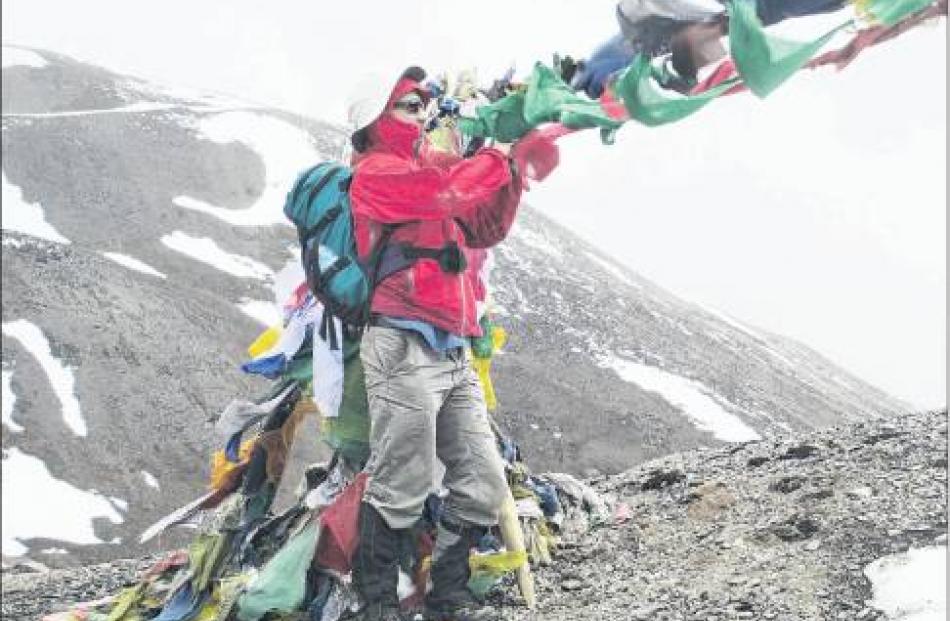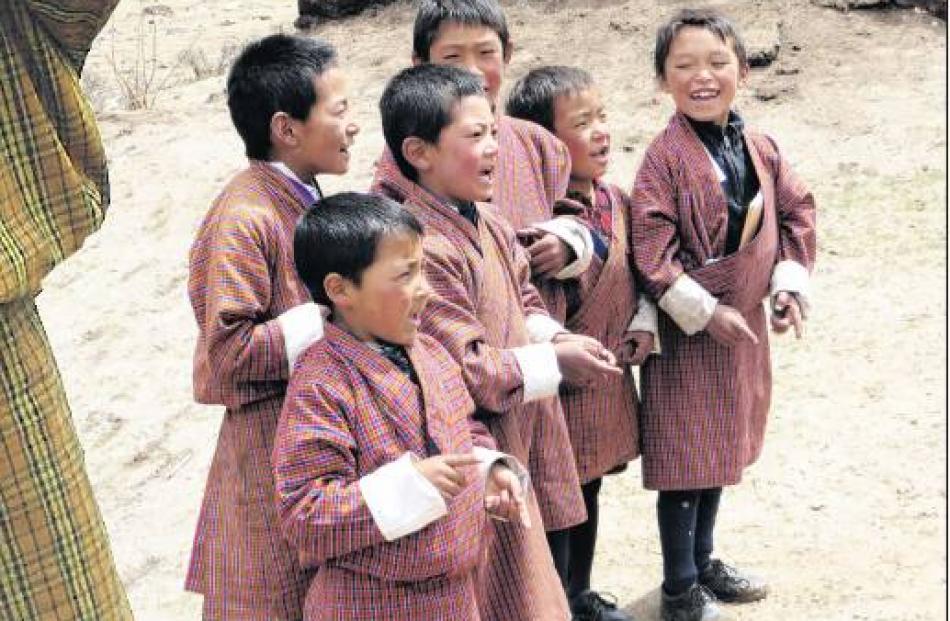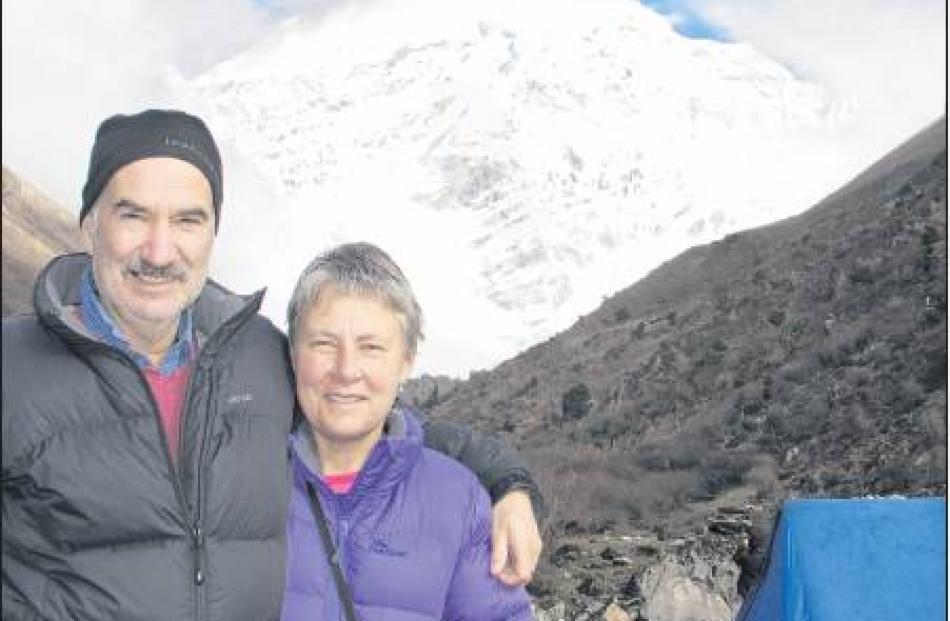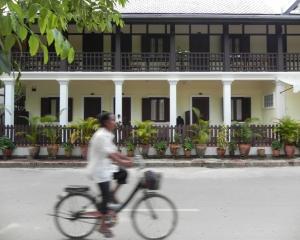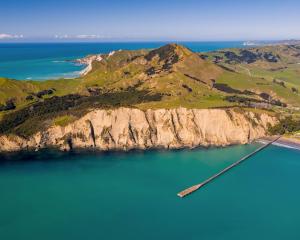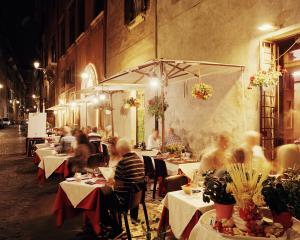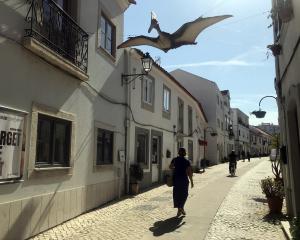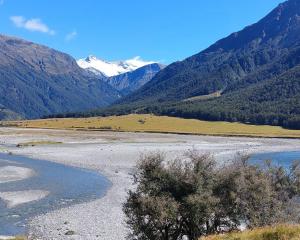Shona Somerville, from Dunedin, treks high into the mountains of Bhutan.
Two of the most magical sounds, to my mind, are the tinkle of pony and yak bells echoing through the freezing stillness of a Himalayan night and the swish of air through wings of a griffin vulture as it soars majestically just overhead.
These are two of many highlights from our two-week trip to Bhutan last year.
Life here has changed little in the past 600 years. People still wear traditional costume and the rhythm remains much the same.
My husband, Philip, and I are here in early spring, with our group led by Cardrona folk singer and mountaineer Martin Curtis.
Part of our tour is cultural, visiting impressive and historic Dzong. These fortress-like edifices house both government administration and the Buddhist monastery and temple for the district.
The other part is an eight-day trek towards the northeast and the Chinese border. We are one of the last treks before the monsoon season.
First, some altitude training, a day climbing up to the spectacular Tiger's Nest, a Buddhist monastery that clings to a cliff face.
Altitude is a challenge to even the fittest. You soon learn what your body will allow and, for the unaccustomed, there is no such thing as fast.
Our trek involves a circuit past the base camp at Jhomolhari and back to near Paro where we are staying - well that's the plan.
Our party, apart from the eight of us, includes 20 ponies and mules, three pony ‘‘boys'', our Bhutanese guide Chundhu (who accompanies us for all our time in Bhutan), a cook and his assistants.
Each day begins about 6am with a cup of tea brought to our tents, then a bowl of hot water for a wash. Breakfast is in the dining tent while ours are taken down. Then it's day packs on and we are away.
The cook's boys catch us up with morning tea and lunch. By early afternoon our ponies are a welcome sight and sound, passing with our luggage and supplies.
Everything we need including gas for cooking and feed for the ponies is carried.
After seven to eight hours' trekking we arrive at our next camp with tents set up, hot tea and water for washing ready. A three-course meal by head torch follows in due course and soon it is off to bed.
We clasp our still warm drink bottles of boiled water. It will give me comfort and warmth in my down sleeping bag. On the coldest night this was a welcome addition to my two pairs of thick woollen socks, two pairs of long johns, three merino tops and a woollen hat.
Most Bhutanese walk wherever they need to go. Formed roads are few and most are unsealed. Our dirt and sometimes rocky path takes us up a valley and over several passes.
We catch up with a pony train returning home with summer food supplies from the local town.
By this time of year and before real spring growth, animals are weaker and their carrying capacity less. We see dead livestock on our journey. Life is harsh up here, Chundhu tells us.
Our new female companion is wealthy. She owns 100 yaks. She has two husbands (yes you can have several here, but only one is legal).
Of her six children, only this one son remains in the mountains to help her. The rest have gone to the capital, Thimphu, for further education and jobs. She thinks my husband is handsome, Chundhu translates.
Hmmmm . . .? Hands off!
There is great excitement to see our first yak and her calf. We keep our distance. Yaks are found at higher altitudes where temperatures are cooler. In the summer they are taken to even higher pastures to graze.
Our group includes avid bird watchers who, with their keen eyes and binoculars, manage to spot, identify and photograph a wide variety of birds.
We learn a lot. You have to be quick to see other fauna too, including marmots and a flock of rare blue sheep.
I see early spring flowers that grow in my garden. Many of our garden flowers originate in the Himalayas, including rhododendrons and primulas.
Farmhouses are dotted sparsely up the valley. I am excited to find most traditional Bhutanese houses are built of rammed earth. They are solid and, like all good earth houses, have rock foundations and a ‘‘good hat''.
While we see some new building, most houses look generations old. The open roof cavity is often used for drying hay and strips of yak meat. Intricate painting often decorates the upper outside walls.
Large graphic phalluses can feature prominently, warding off evil spirits and malicious gossip.
Chundhu liked to tease us about these. He enjoyed playing on Western women's sensibilities.
We delight in coming across a small rural primary school with its 13 pupils and two teachers. The children in their traditional costume come over to greet us and sing us songs, some in English.
English is taught in all schools in Bhutan. We sing them songs and share Kay Curtis' bubble-blowing mixture.
We are invited into their simple classroom and listen to their reading and writing. I wish I had brought some New Zealand story books to leave with them.
Our third and fourth nights are spent at 4000m, allowing the body extra time to adjust to the increasing altitude. I am starting to feel better with some medication for altitude sickness, which had come on as we approached the previous camp.
After a good puke and going straight to bed, things are literally looking up. Altitude sickness can be very serious.
This is the biggest campsite. Later as we gaze down on the specks of our blue tents we observe four other camping parties, one a small Bhutanese army group.
We encounter army personnel several times along the way, often travelling in pairs and giving us a cheery wave and greeting.
The ‘‘porous'' Chinese (Tibetan) border is monitored with Bhutanese/Indian collaboration. We pass through an outpost and Chundhu presents our travel documents.
Our first night at the base camp and the following day were memorable for several reasons.
A rhythmic thump, thump, thump disturbed everyone's sleep until the early hours.
It turned out the pony boys (really young men with families) enjoyed gambling, upending a small wooden bowl forcefully on the floor as they threw dice.
We wake to an airy stillness and the sound of snow sliding off our tent as a passing pony catches a hoof on our guy rope. Outside it is just magic.
A ‘‘training'' ascent of the nearby hill gives us a wonderful snow-covered view of where we had come from and to the hanging valley we were due to travel to the next day.
There is a definite absence of pony bells when we return for lunch, and for good reason . . . our ponies had gone!
Disgruntled at being chastised and not getting their breakfast when they wanted, the pony boys and ponies had departed and we find ourselves stranded.
We are glad it is not our problem. As Bhutan juggles and struggles to retain its spiritual, historical and cultural identity in the face of economic development and outside influences, young people are finding more lucrative and less demanding ways to earn a living.
Harvesting the highly priced and sought after caterpillar fungus, a Chinese medicinal cure, is one such way for some.
Bhutan's extensive mobile phone coverage is astounding - the envy of the Australians in our group.
With Chundhu on long phone conversations and our cook spending the night approaching families and other pony men up and down the valley, eventually an arrangement is made to take us over the pass at 4800m but no further than the next camp.
If no more ponies, or yaks, are found we will have to return the way we came.
We are OK with that, having covered most of the more interesting parts of the trail.
We all feel elated, but exhausted, making it over the pass. Traditionally, a string of prayer flags are hung on passes and Philip and I each carry one for that purpose. It seems appropriate and symbolic.
As we retrace our steps back over the pass and down the valley, spring is speeding up and the landscape is changing.
The end finally comes into sight. With falling rain no-one wants to dawdle. As the last person clambers on to our waiting minibus we are off.
Looking forward to a hot shower, clean clothes and a comfortable bed, the last things we expect are the cream cake and beer that greet us.
But it is not easy drinking on the bumpy road. Get ready to gulp. There's a bridge ahead and it's smooth. Cheers and well done everyone!
Population: 750,000.
Area: About 38,000sq km (Otago is 31,000sq km).
State religion: Buddhism.
Guided tours only. Minimum $US250 a day. $US65 aday goes straight to the Government. All itineraries must be approved by Bhutan’s Tourism Council, and tour must be accompanied by a local guide. Constitutional monarchy from 2008. Kingdom 1907. Famous for Gross Domestic Happiness as the only country to measure "happiness". Ban lifted on television and the internet in 1999.
Bhutan is known as the Land of the Thunder Dragon. Druk, the dragon of Bhutanese mythology, features on the flag. The origins are thought to arise from the sounds of violent storms in the mountains. The national airline is Drukair — Royal Bhutan Airlines.

